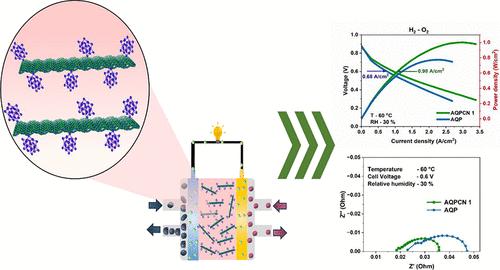低湿条件下聚合物电解质燃料电池用氮化石墨碳上稳定超酸性短侧链膜
IF 8.2
2区 材料科学
Q1 MATERIALS SCIENCE, MULTIDISCIPLINARY
引用次数: 0
摘要
超酸类杂多酸的集成为开发高质子导电的能量存储和转换膜提供了一条有前途的途径。然而,这些酸固有的亲水性会导致浸出,从而破坏燃料电池的性能。在我们的研究中,我们设计了一种质子导电膜,采用简单的水热合成方法,与氮化石墨碳(PCN)形成稳定的杂化超强酸,即磷钨酸(PTA),并将其掺入短侧链离聚体Aquivion中。这种独特的方法通过PCN纳米杂化体增强了质子在膜内的传输。这些纳米杂化体有效地将PTA的强酸性与通过短侧链的连续二维质子传输途径结合在一起,在80°C和95%相对湿度下,质子电导率达到0.228 S cm-1。aquvion /PCN纳米复合膜对燃料电池性能的影响是明显的,在0.6 V的低相对湿度(30% RH)下,纳米复合膜的峰值功率密度(1.0 W cm-2)显著提高34%,电池性能(0.98 a cm-2)保持44%。这一进步代表了低湿度条件下能量转换和存储技术的重大飞跃。本文章由计算机程序翻译,如有差异,请以英文原文为准。

Short-Side-Chain Membranes with Stabilized Superacid on Graphitic Carbon Nitride for Polymer Electrolyte Fuel Cells under Low-Humidity Conditions
The integration of superacid-like heteropolyacids offers a promising route to develop highly proton-conducting membranes for energy storage and conversion. However, the inherent hydrophilicity of these acids can cause leaching, which undermines the fuel cell performance. In our research, we engineered a proton-conductive membrane with a facile hydrothermal synthesis approach to form stabilized hybrid superacids, namely, phosphotungstic acid (PTA), with graphitic carbon nitride (PCN) and its incorporation in a short-side-chain ionomer, namely, Aquivion. This unique approach via PCN nanohybrids enhances the proton transport within the membrane. These nanohybrids effectively combined the strong acidity of PTA with continuous 2D proton-transport pathways via a short side chain, resulting in a notable proton conductivity of 0.228 S cm–1 at 80 °C under 95% relative humidity. The real impact was evident in the performance of fuel cells using the Aquivion/PCN nanocomposite membrane, which demonstrated a significant improvement of 34% in the peak power density (1.0 W cm–2), and 44% cell performance (0.98 A cm–2) was retained for the nanocomposite membrane at a low relatively humidity (30% RH) at 0.6 V. This advancement represents a major leap in energy conversion and storage technologies at low-humidity conditions.
求助全文
通过发布文献求助,成功后即可免费获取论文全文。
去求助
来源期刊

ACS Applied Materials & Interfaces
工程技术-材料科学:综合
CiteScore
16.00
自引率
6.30%
发文量
4978
审稿时长
1.8 months
期刊介绍:
ACS Applied Materials & Interfaces is a leading interdisciplinary journal that brings together chemists, engineers, physicists, and biologists to explore the development and utilization of newly-discovered materials and interfacial processes for specific applications. Our journal has experienced remarkable growth since its establishment in 2009, both in terms of the number of articles published and the impact of the research showcased. We are proud to foster a truly global community, with the majority of published articles originating from outside the United States, reflecting the rapid growth of applied research worldwide.
 求助内容:
求助内容: 应助结果提醒方式:
应助结果提醒方式:


